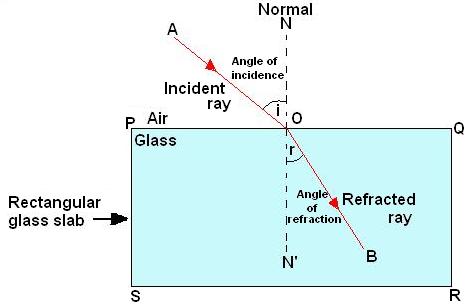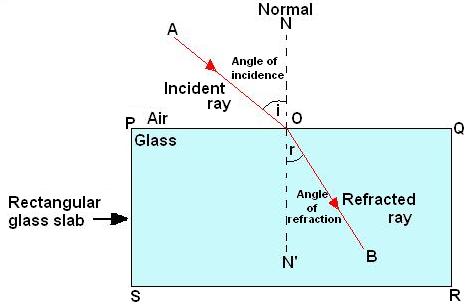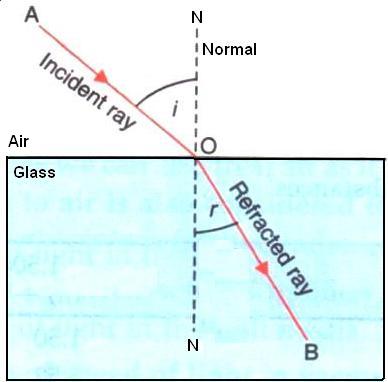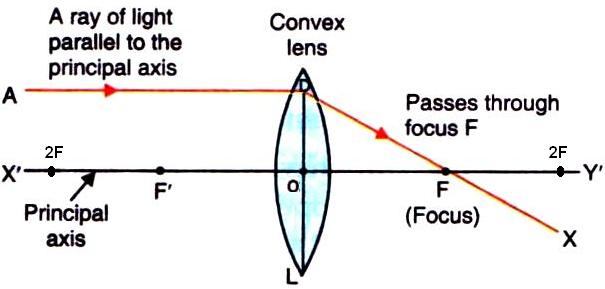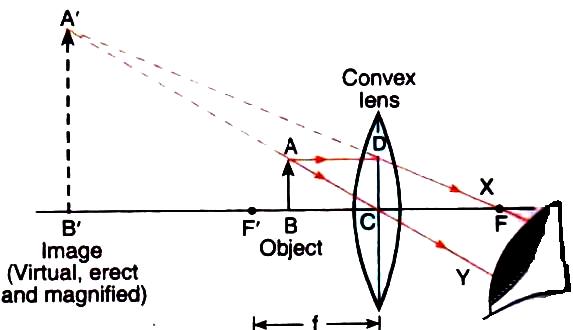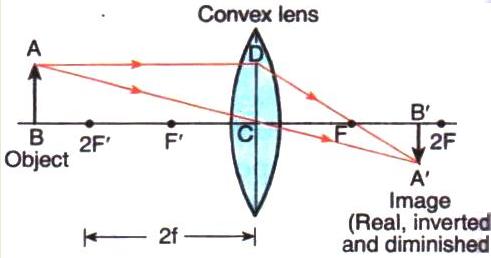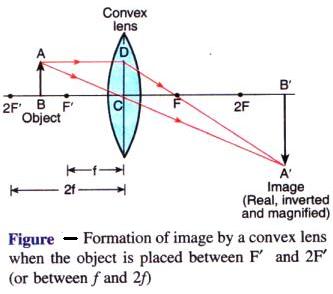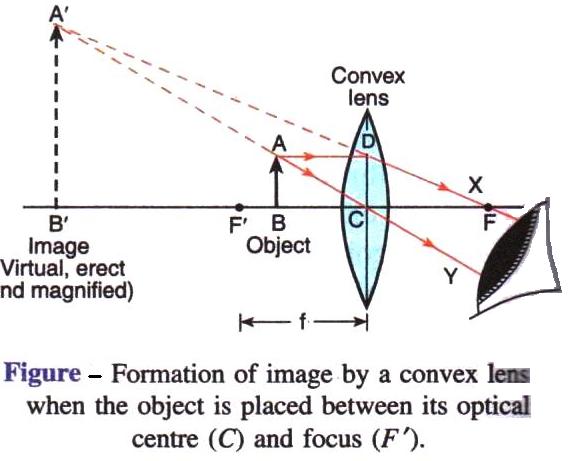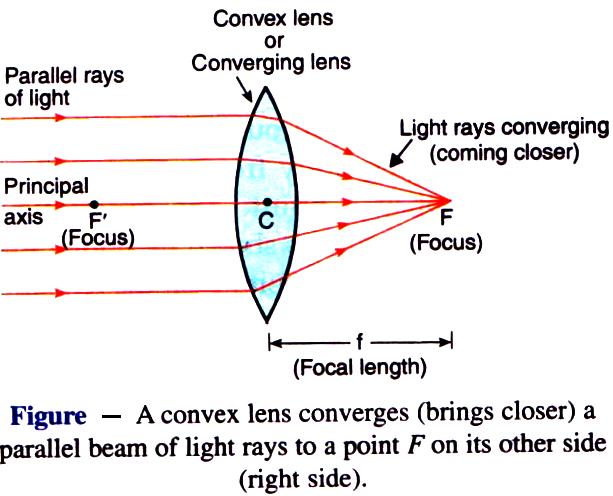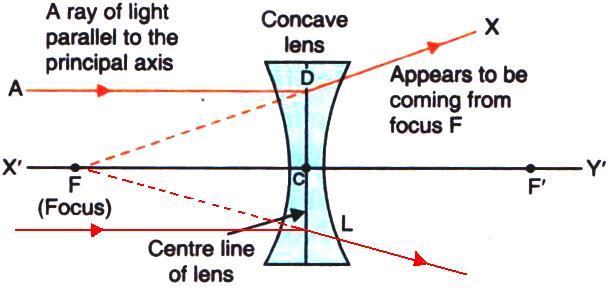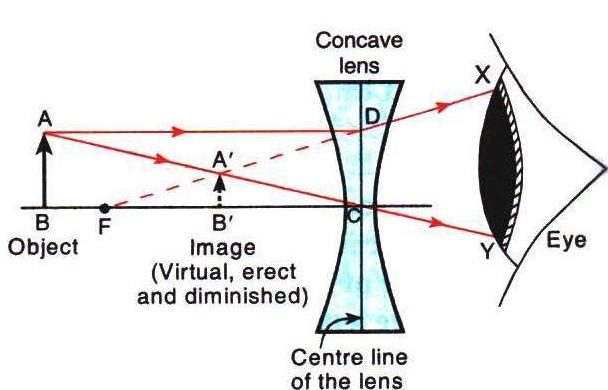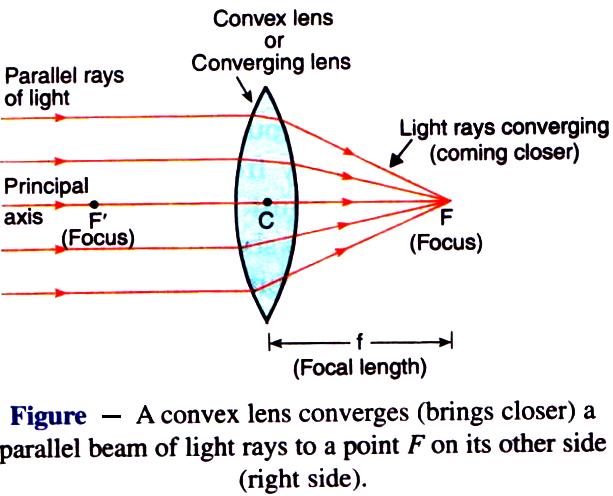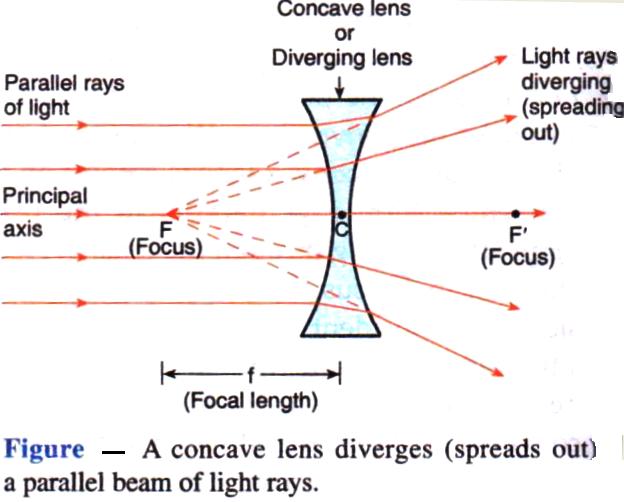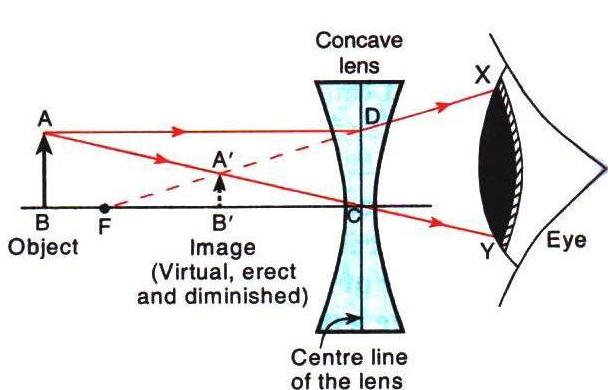Class 10 LAKHMIR SINGH AND MANJIT KAUR Solutions Physics Chapter 5 - Refraction of Light
Refraction of Light Exercise 219
Solution 1
It will bend towards the normal.
Solution 2
It will bend away from the normal.
Solution 3
A ray of light travelling from the glass slabs and emerges into the air.
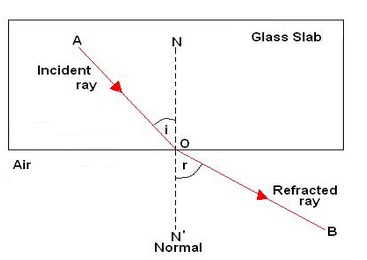
Solution 4
Solution 5
A ray of light travelling through water to air.
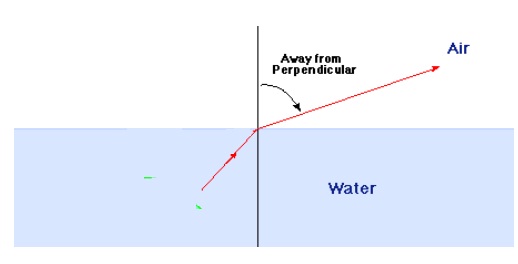
Solution 6
A ray of light incidence on parallel sided glass slab.
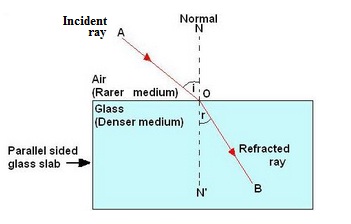
Solution 7
The ray of light will bend away from the normal.
Solution 8
The ray of light bends towards the normal. This is because water is an optically denser medium than air.
Solution 9
It will bend away from the normal.
Solution 10
Two effects caused by refraction of light are:
- a pool of water appears to be less deep than it actually is.
- an object placed under water appears to be raised.
Solution 11
This is due to refraction of light.
Solution 12
Angle of refraction is less than the angle of incidence.
Refraction of Light Exercise 220
Solution 13
A ray of light travelling from air to glass block, will bend towards the normal.
Solution 14
A ray of light travelling from water into glass will bend towards the normal.
Solution 15
Light rays travel faster in air.
Solution 16
Refraction of light
Solution 17
Solution 18
A ray of light bends when it travels from one medium to another due to the change in the speed of light.
Solution 19
(a) not
(b) refracted
Solution 20
The change in direction of light when it passes from one medium to another obliquely, is called refraction of light.
Solution 21

The final direction of the ray of light is same as the incident direction.
Solution 22
(a) Ray of light travelling from air into an optically denser medium.
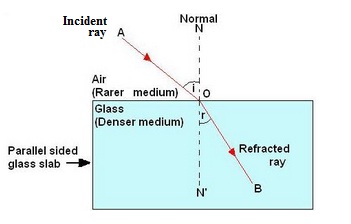
(b) Ray of light travelling from an optically denser medium into air.
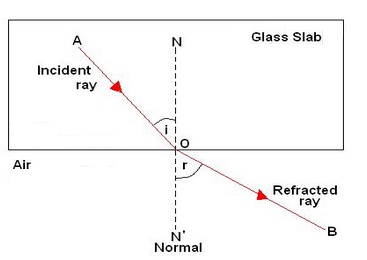
Solution 23
(a)
(b)
Solution 24
The angle between the incident ray and normal at the point of incidence is called angle of incidence.
The angle between the refracted ray and normal at the point of refraction is called angle of refraction.
Solution 25
(a) Glass is optically denser than the water.
(b) The ray will bend away from the normal.
Solution 26
(a) If ray of light hits the block at 90o
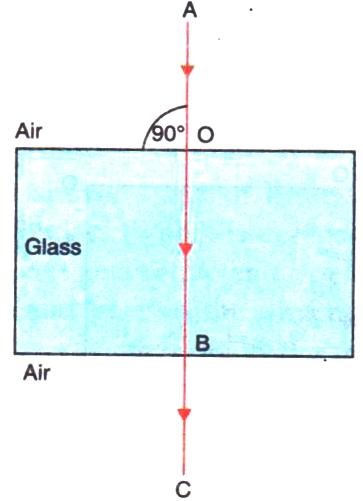
(b) If ray of light hits the block other than the 90o
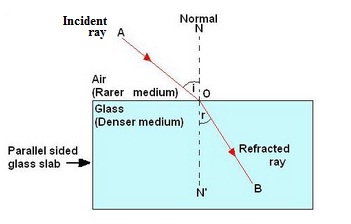
Solution 27
When a light ray passes from air into glass, the speed of the ray decreases.
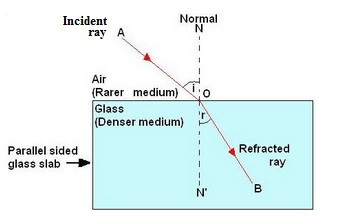
The ray of light bends towards the normal.
Solution 28
(a) The apparent bending of the stick is due to the refraction of light when it passes from water into air.
A ray of light OC coming from O passes from water into air and gets refracted away from normal (along CX). Another ray OD gets refracted along DY. The two refracted rays CX and DY, when produced backwards, appear to meet at point I. Thus, I is the virtual image of the end O of the stick. So, the stick appears to be bent as shown below.
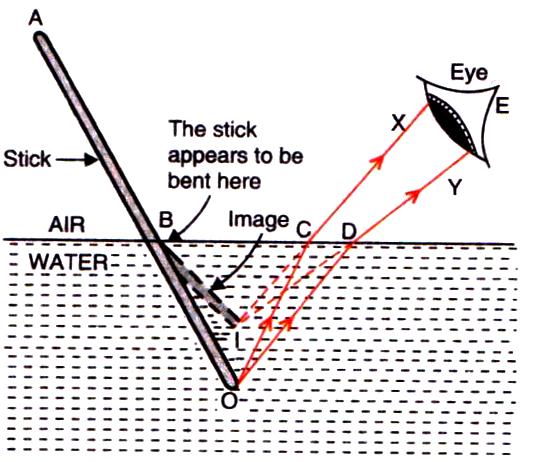
(b) This phenomenon is due to the refraction of light as it comes out from water into air.?
Solution 29
(a) If we look into a tank of water, it appears to be less deep than it really is. This is due to the refraction of light which takes place when light rays pass from the tank of water into air. When we look into the tank, we do not see the actual bottom of the tank, we see a virtual image of the bottom of the pool which is formed by the refraction of light coming from the water into the air.
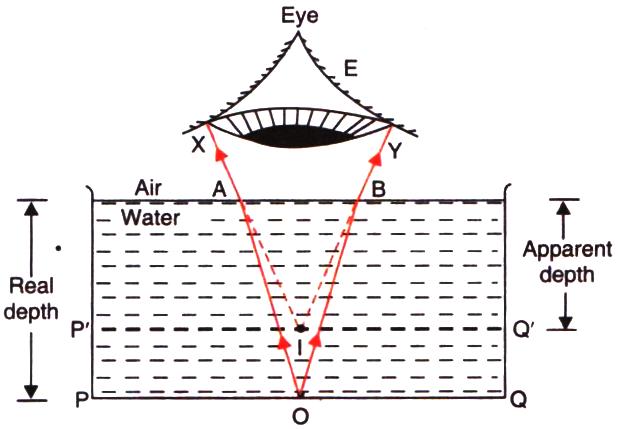
(b) Refraction of light
Solution 30
(a)
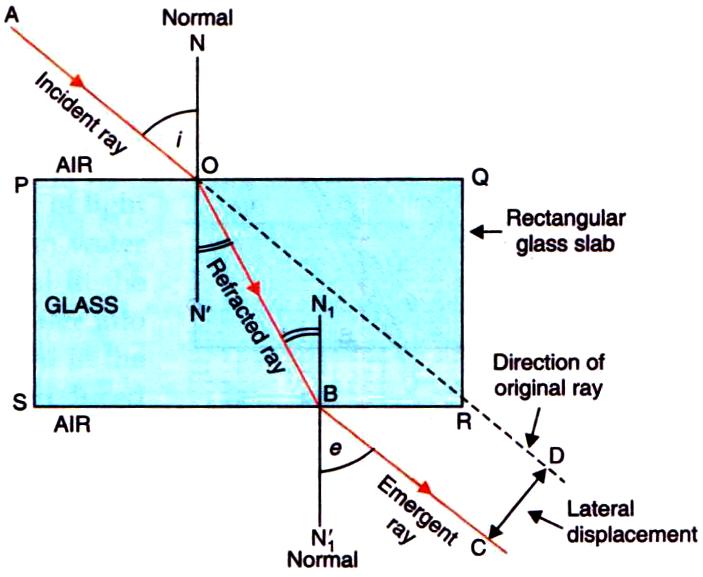
(b) The lateral displacement is shown in the above diagram.
(c) Factors on which the lateral displacement depends are:
(i) Angle of incidence
(ii) Thickness of glass slab
(iii) Refractive index of glass slab
Solution 31
A pencil placed in water appears to be bent because of refraction of light. The refraction causes an apparent shift in the position of the part of the pencil within the water.
If water is replaced by another liquid which is optically more dense than water, then the bending of the pencil will increase. This is because the optically denser medium will cause more refraction of light rays.
Refraction of Light Exercise 221
Solution 39
Solution 40
(a) 00
(b) 00
Solution 41
The angle of reflection is equal to the angle of incidence but the angle of refraction is not equal to the angle of incidence.
Solution 42
(a) Obliquely; making a large angle of incidence.
(b) Perpendicular to the glass surface.
Solution 43
(a) By making the light enter from a denser medium to a rarer medium.
(b) Incidence should be at right angle to the surface of substance.
Solution 44
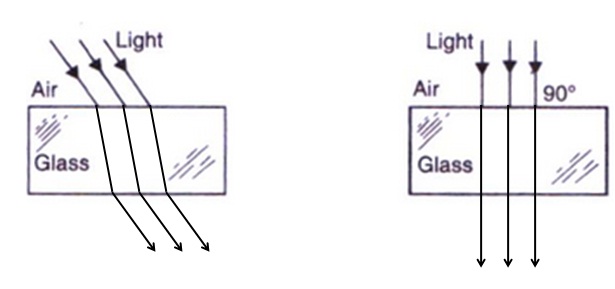
Solution 45
A beam of light bends when it enters glass at an angle. This is due to refraction of light. It does not bend if it enters the glass at right angles because no refraction will occur in this case, the angle of incidence in this case is zero and angle of refraction is also zero.
Refraction of Light Exercise 227
Solution 1
Refractive index
Solution 2
![]()
Refraction of Light Exercise 228
Solution 3
Refractive index has no units.
Solution 5
Carbon disulphide is more denser than the ethyl alcohol.
Solution 6
This means that the ratio of the speed of light in air to the speed of light in diamond is equal to 2.42.
Solution 7
Solution 8
Solution 9
Refractive index
Solution 10
Solution 11
Snell's law: According to the Snell's law of refraction, the ratio of sine of angle of incidence to the sine of angle of refraction is constant for a given pair of media.
![]()
Given: Angle of incidence=60o
Angle of refraction=32.4o
![]()
Solution 12
Solution 13
Given:
Speed of light in air=3.0x108m/s
Speed of light in medium X=2.0x108m/s
Speed of light in medium Y=2.50x108m/s
(a) airnx=?
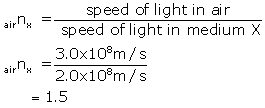
(b) airny=?
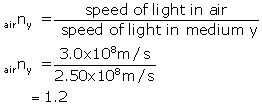
(c) xny=?
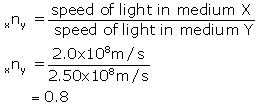
Solution 14
Refractive index of medium=6/5=1.2
Speed of light in air=3,00,000km/s
We know that

Solution 15
Given:-
Refractive index of glass=1.5
Speed of light in air=3.0x108m/s
We know that

Solution 16
Speed of light in vacuum=3.0x108m/s
Speed of light in water=2.25 x108m/s
Refractive index of water=?
We know that

Solution 17
Given:-
Refractive index of diamond=2.42
Speed of light in air=3.0x108m/s
We know that

Solution 18
(a) Laws of refraction:
First law: According to the first law of refraction, the incident ray, the refracted ray and the normal at the point of incidence, all lie in the same plane.
Second law: According to the second law of refraction, the ratio of the sine of angle of incidence to the sine of angle of refraction is constant for a given pair of media.
(b) Refractive index of substance: The ratio of speed of light in vacuum to the speed of light in a medium, is called the refractive index of that medium.
(c) Speed of light in air =300milion m/sec
Speed of light in water=225milion m/sec
We know that

Solution 4
Refraction of Light Exercise 229
Solution 29
(i) Crown glass to water
(ii) Water to diamond
Solution 30
(i) A (It has least refractive index)
(ii) D (It has highest refractive index)
Refraction of Light Exercise 239
Solution 1
Converging lens
Solution 2
Optical center
Solution 3
Solution 4
At 2F (At twice the focal length)
Solution 5
The image is formed at infinity (at very large distance).
Solution 6
Object should be placed at a distance less than focal length.
Solution 7
The object should be placed within focus.
Solution 8
Object should be placed between f and 2f.
Refraction of Light Exercise 240
Solution 9
Beyond 2F
Solution 10
At focus F
Solution 11
Solution 12
Convex lens
The object must be withing the focus of the lens.
Solution 13
Solution 14
Two uses of convex lenses:-
1. As a magnifying glass
2. For making a simple camera
Solution 15
a) focus
b) object
Solution 16
A lens is a piece of transparent glass bound by two spherical surfaces.
A convex lens is thicker at the middle as compared to the edges; while a concave lens is thicker at the edges as compared to the middle.
Convex lens is converging lens.
Solution 17
(a) A convex lens also known as converging type because it converges a parallel beam of light rays passing through it.
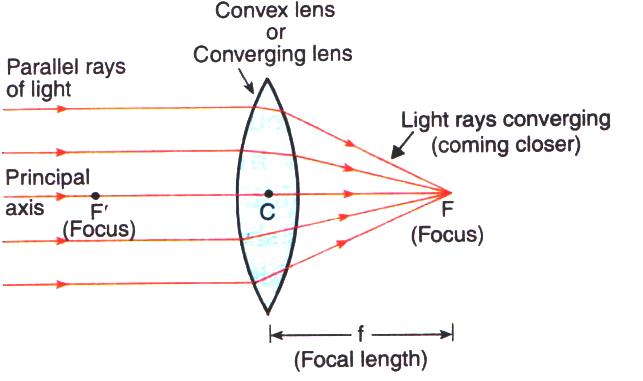
(b) Principle axis: The principal axis of a lens is a line passing throught the optical centre of the lens and perpendicular to both the faces of the lens.
Principle focus: The principal focus of a convex lens is a point on its principal axis to which light rays parallel to the principal axis converge after passing through the lens.
Focal length: The distance of the principle focus from the optical center of a lens is called its focal length.Solution 18
(a) A concave lens is known as diverging lens because it diverges the parallel rays of light passing through it.
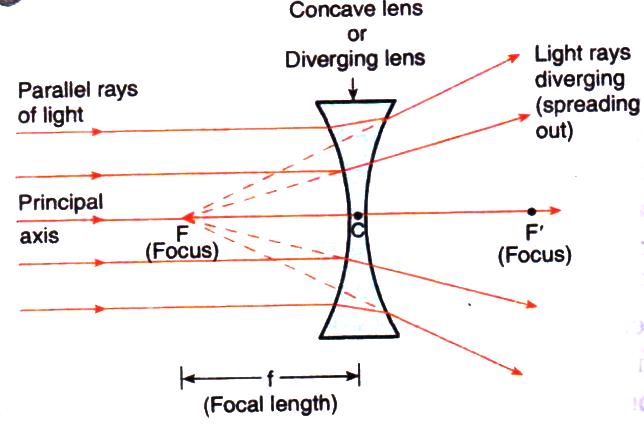
(b) The principal focus of a concave lens is a point on its principal axis from which light rays, originally parallel to the axis, appear to diverge after passing through the lens.
Solution 19
Formation of real magnified image by a convex lens.
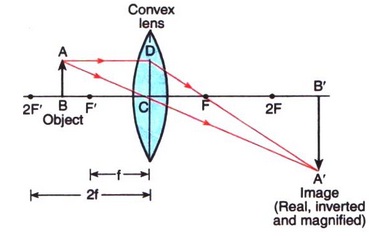
Solution 20
If object is placed in between f and 2f, the image will form on the other side of the lens beyond 2f as shown below.
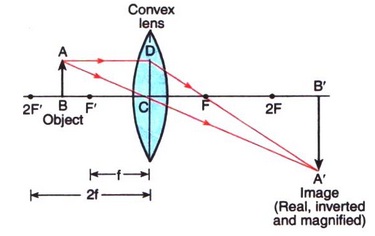
Characteristics of image formed:
Image formed is real and inverted.
Image formed is magnified.
Solution 21
In the diagram, the object is placed in front of a convex lens between focus and optical centre. The image is formed on the same side as the object as shown below.
Characteristics of image formed:
Image is virtual and erect.
Image is larger than the object
Image is formed behind the object.
Solution 22
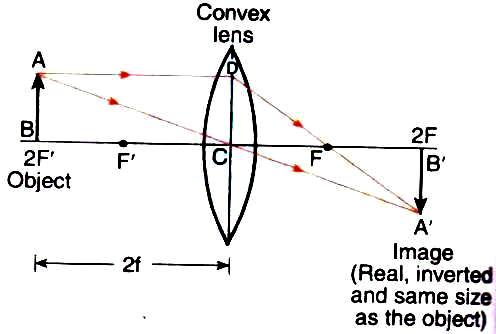
Characteristic of image formed:
Image formed is real and inverted.
Image is of same size as the object.
Solution 23
When an object is placed beyond 2f in front of a convex lens, then the image formed is between f and 2f on the other side of the lens, it is real, inverted and smaller than the object.
Solution 24
When an object is placed at infinity in front of a convex lens, the image is formed at the focus on the other side of the lens.
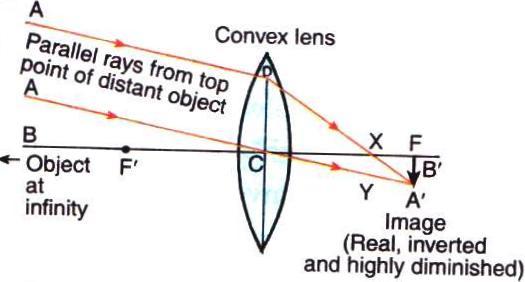
Characteristics of image formed:
Image is real.
Image is inverted.
Image is highly diminished.
Solution 25
(a) The lens shown in convex. the parallel rays will converge to a point called focus (F).
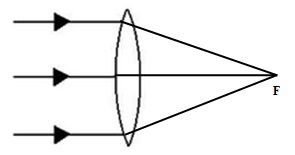
(b) It is unwise to look at the sun because the convex lens focusses a lot of sun rays into our eyes and this may damage them.
Solution 26
a) Beyond 2F
b) At 2F
c) Between F and 2F
d) Between F and optical centre
Solution 28
To determine the focal length of a convex lens, we put the convex lens in a holder and keep it in front of a distant object like a window or tree, so that the rays coming from the window pass through it. A cardboard screen is put behind the lens. We change the distance of the screen from the convex lens until a clear inverted image of the window is formed on the screen. Measure the distance of the screen from the lens with a scale. This distance will be the focal length of convex lens.
Solution 29
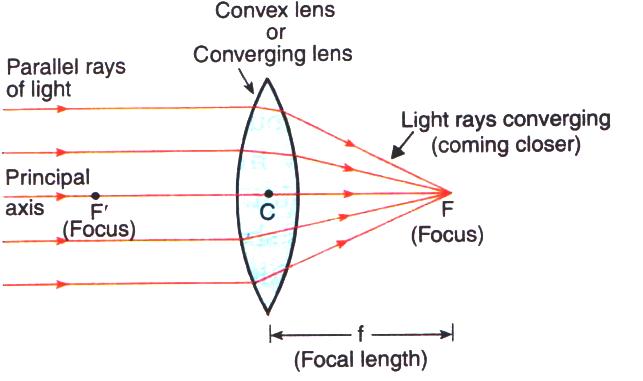
(b) A convex lens has a real focus.
(c) Both, convex lens and concave mirror, converge parallel rays of light coming from infinity (parallel to the principal axis) at the focus.
Solution 27
Converging lens as a magnifying glass:
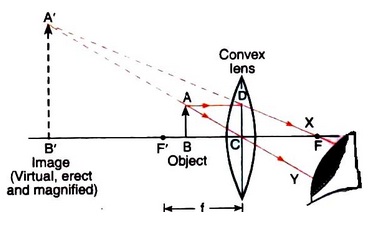
It is usual to choose a lens of short focal length for this purpose rather than one of long focal length because smaller the focal length of a convex lens, greater will be its magnifying power.
Refraction of Light Exercise 241
Solution 30
(a)
When a beam of light rays parallel to one another and also to the principal axis of the concave lens fall on the lens, the incident rays pass through the lens and get refracted according to the laws of refraction. All the rays spread out after passing through the lens. These diverging rays when produced backwards appear to meet at a point F (focus) on the left side of the lens.
(b) A concave lens has a virtual focus.
(c) Both, concave lens and convex mirror, diverge parallel rays of light coming from infinity (parallel to the principal axis).
Solution 31
(a) Object at 2F1 :
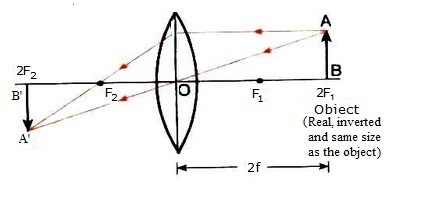
(b) Object between F1 and the optical centre O of the lens :
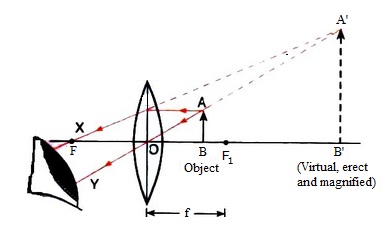
The case when object is between F1 and the optical centre O of the lens shows the use of convex lens as a magnifying glass. This is because here the image formed is erect and magnified.
Solution 32
a)
(b)
(i) If object is moved towards the lens, the image size will keep on increasing till the object reaches focus. After that, the size decreases but the image remains magnified. The image keeps movingvaway from the lens (on the opposite side of the lens) till the object reaches focus; after that the image is formed on the same side of the lens as the object.
(ii) If object is moved away from the lens, the size will keep on decreasing and the image keeps on shifting towards the lens.
Solution 33
(a) A virtual magnified image is the one which cannot be taken on a screen and whose size is larger than that of the object.
(b)
(c) Convex lens having 4 cm focal length - because it will produce greatest magnification.
Solution 34
a) A real image can be projected on a screen but a virtual image cannot because a real image is formed when light rays coming from an object actually meet at a point after refraction through a lens while a virtual image is formed when light rays coming from an object only appear to meet at a point when produced backwards (but do not actually meet) after refraction through a lens.
b)
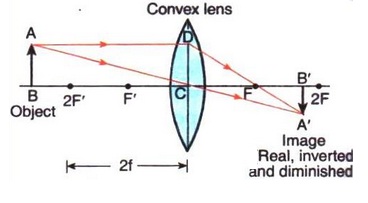
c) A simple camera
Refraction of Light Exercise 242
Solution 46
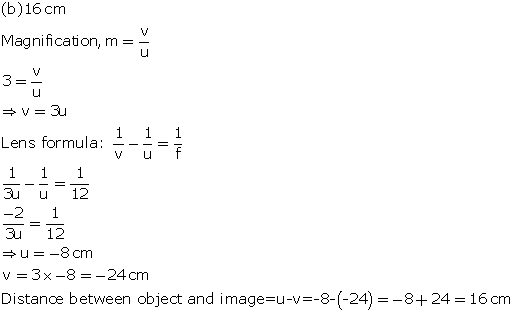
Solution 47
(b) 10 cm
The image is slightly smaller than the object when the object lies beyond 2f; and the image is slightly larger than the object when the object between f and 2f. This means that between 21 cm and 19 cm lies 2f. Out of the given options, 20 cm lies between 21 cm and 19 cm.
So, 2f = 20 cm
f = 10 cm
Solution 48
Here, f=15cm and 2f=30cm
(i) 20 cm (Because a magnified real image is formed when the object is placed between f and 2f)
(ii) 10cm (Because a magnified virtual image is formed when the object is placed between f and the lens)
(iii) 35cm (Because a diminished real image is formed when the object is placed beyonf 2f)
(iv) 30cm (Because an image of same size as the object is formed when the object is placed at 2f)
Solution 49
Here, 2f = 36 cm, f = 18 cm
(a) When the object is placed at a distance of 10 cm from the lens, the object lies within the focus. Hence, the image formed is virtual, erect and magnified.
(b) When the object is placed at a distance of 20 cm from the lens, the object lies between f and 2f. Hence, the image formed is real, inverted and magnified.
Solution 50
(a) A converging lens focusses parallel ray of light as shown below:
(b) Place a source of light at the focus of the converging lens.
Refraction of Light Exercise 246
Solution 1
Formula for a lens connecting image distance (v), object distance (u) and the focal length (f) is:![]()
This is the lens formula.
The lens formula has a minus sign (-) between 1/v and 1/u whereas the mirror formula has a plus sign (+) between 1/v and 1/u.
Mirror formula:![]()
Solution 2
Magnification (m) fomula for a lens is:
![]()
Magnification formula for a mirror has a minus sign (-) but the magnification formula for a lens has no minus sign.
Magnification formula for a mirror is:
![]()
Solution 3
The image will be virtual and erect, since the magnification has positive value.
Solution 4
The image will be real and inverted, since the magnification has negative value.
Solution 5
u = -10 cm, f = 10 cm
We have
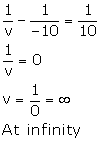
Solution 6
Solution 7
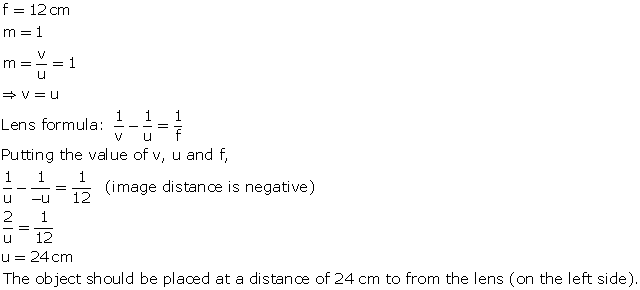
Solution 8
New Cartesian Sign Convention for spherical lenses:
(i) All the distances are measured from the optical centre of the lens.
(ii) The distances measured in the same direction as that of incident light are taken as positive.
(iii) The distances measured against the direction of incident light are taken as negative.
(iv) The distances measured upward and perpendicular to the principal axis are taken as positive.
(v) The distances measured downward and perpendicular to the principal axis are taken as negative.
Solution 9
u = - 10 cm
h1 = 4 cm
f = 20 cm
By Lens Formula

v = -20 cm (Image is 20 cm in front of the convex lens)
We know, magnification of lens is
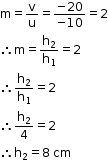
Thus, the image formed by the convex lens is virtual, erect and magnified.
Solution 10
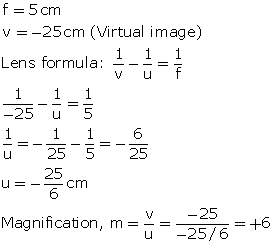
Solution 11
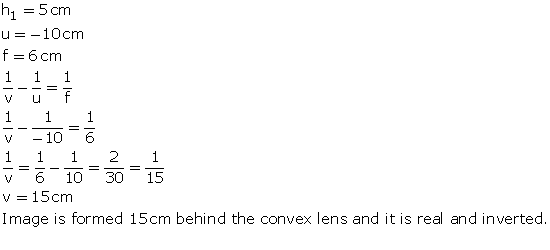
Solution 12
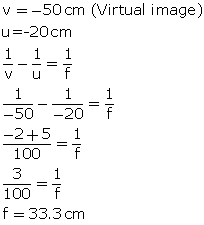
Solution 13
(i) Since the object is placed at a distance greater than the focal length of the lens, so the image formed is real and inverted.
(ii) u = -100cm, f = 40cm

Solution 14
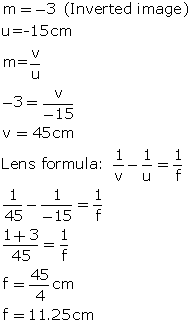
Refraction of Light Exercise 247
Solution 15
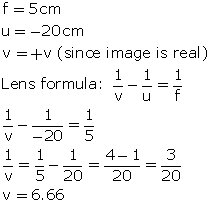
Solution 16
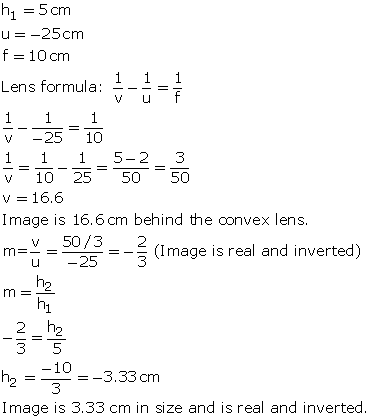
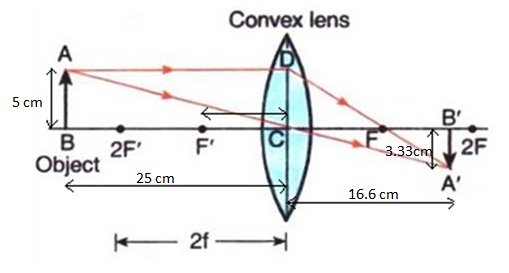
Solution 17
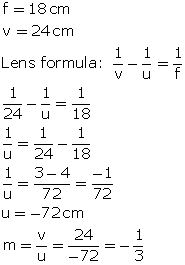
Solution 18
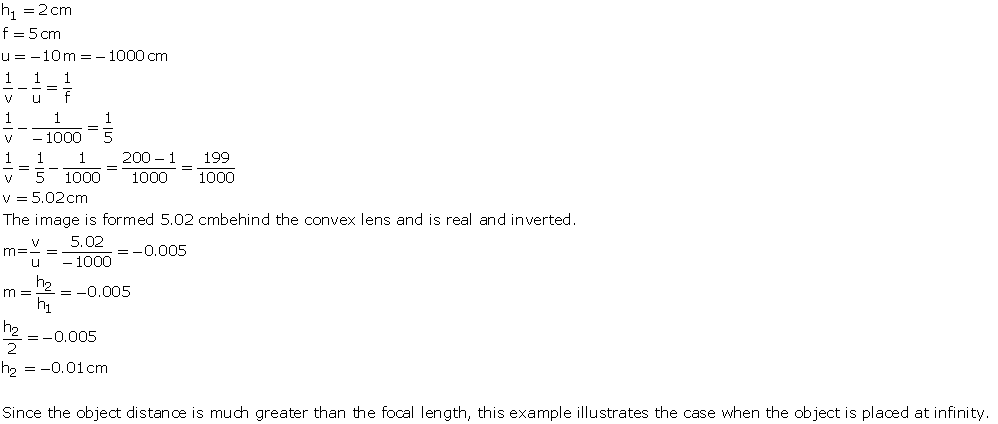
Solution 19
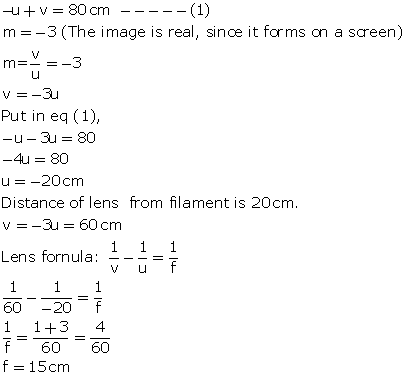
Solution 20
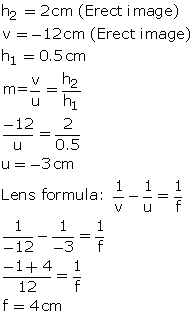
Solution 21
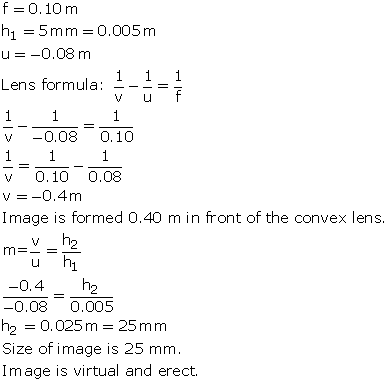
Solution 22
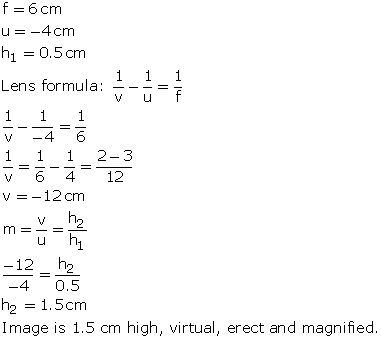
Solution 23
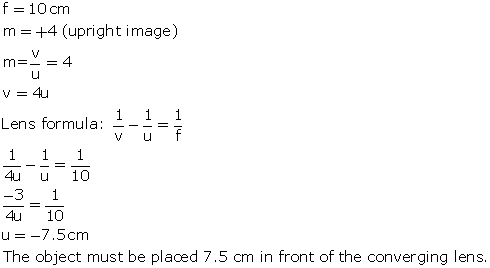
Solution 24
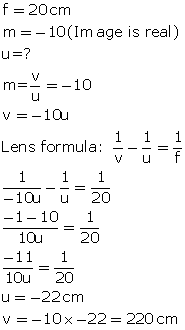
Solution 25
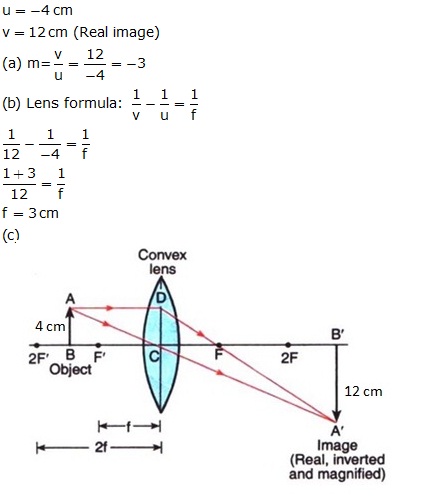
Solution 26
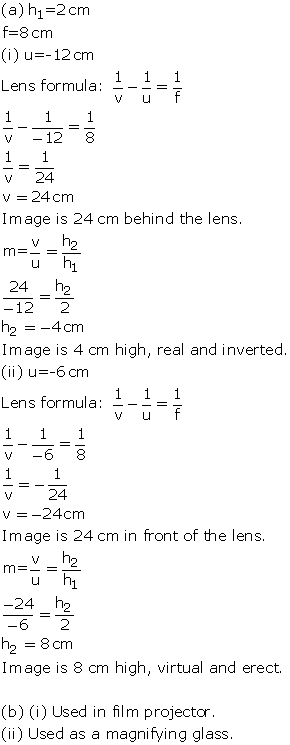
Solution 27
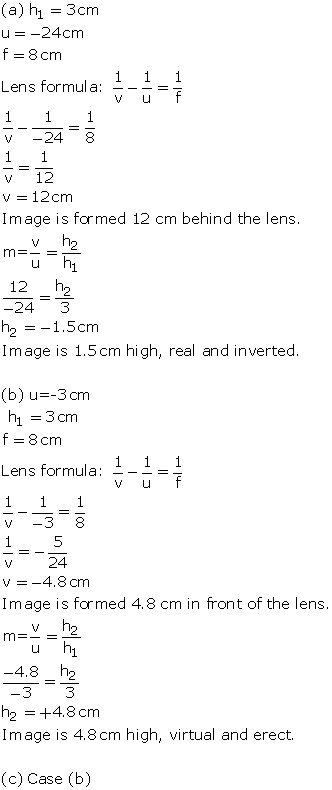
Solution 28
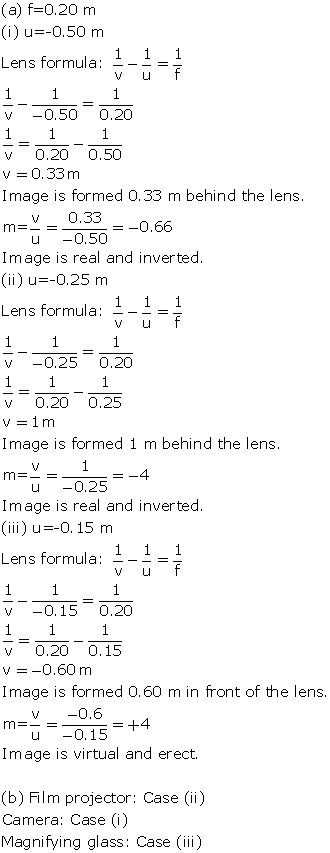
Refraction of Light Exercise 248
Solution 41
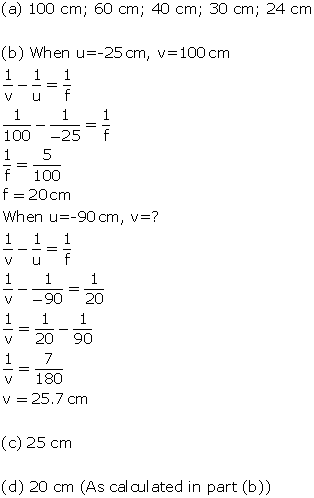
Solution 42
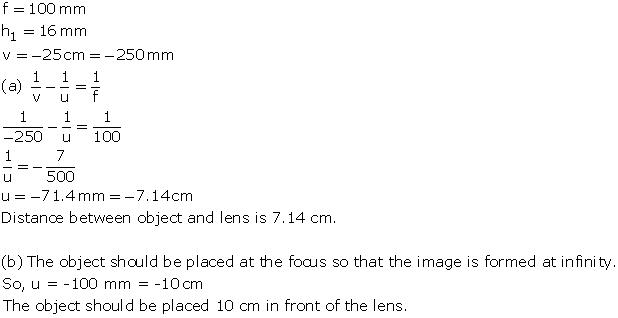
Solution 43
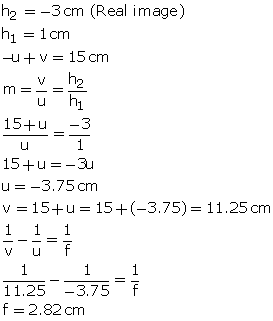
Refraction of Light Exercise 249
Solution 44
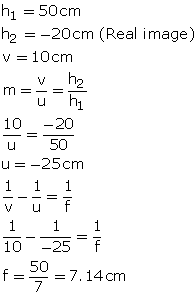
Refraction of Light Exercise 251
Solution 1
Concave lens
Solution 2
Refraction of Light Exercise 252
Solution 3
(a) Concave lenses
(b) Convex lenses
Solution 4
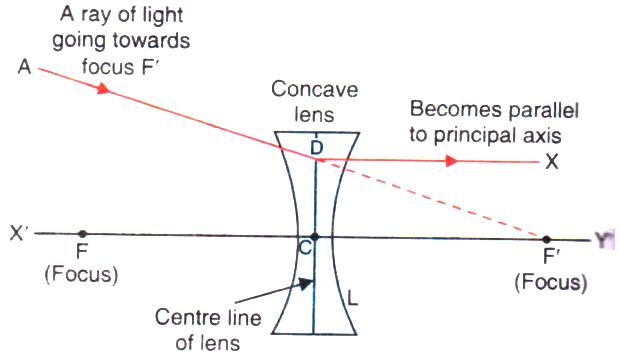
Ray of light going towards the focus of a concave lens.
Solution 5
(a) Real and virtual
(b) Virtual
Solution 6
Solution 7
(a) converges; diverges
(b) converging; virtual
Solution 8
Concave lens
Solution 9
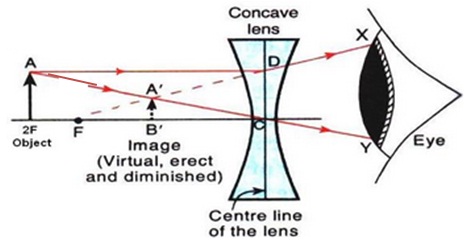
Solution 10
Solution 11
(a) When the object is placed anywhere between optical centre and infinity, the image is formed between optical centre and focus. It is diminished, virtual and erect.
(b) When the object is placed at infinity, the image is formed at focus. It is highly diminished, virtual and erect.
Solution 12
(a) A convex lens is a converging lens because it converges a parallel beam of light rays passing through it at its focus.
(b) A concave lens is a diverging lens because it diverges the parallel beam of rays passing through it.
Solution 13
As shown by the diagram, the image of an object viewed through a concave lens appears smaller and closer than the object.
Solution 14
(a) Smaller
(b) Bigger
Image is virtual in both the cases.
Solution 15
(a)
(i)
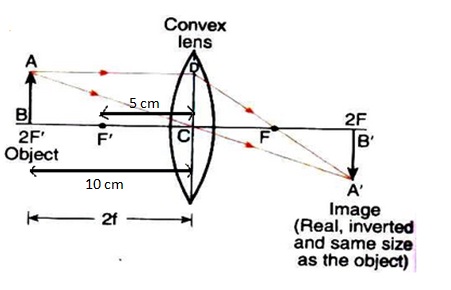
(ii)
(b) Use of convex mirror: As rear-view mirror in vehicles
Use of concave mirror: As shaving mirrors
Use of convex lens: For making simple camera
Use of concave lens: As eye-lens in Galilean telescope
Solution 16
(a)
(i) Formation of virtual image using a converging lens:
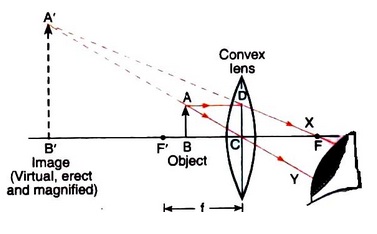
(ii) Formation of virtual image using a diverging lens:
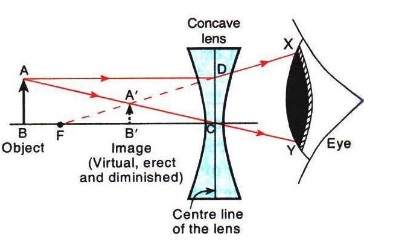
(b) The virtual image formed by a converging lens is magnified whereas that formed by a diverging lens is diminished.
Refraction of Light Exercise 253
Solution 23
(a) The object is placed at focus, so f=10 cm.
(b) the object is placed at a distance twice the focallength, so f=5 cm.
(c) Convex lens (since image is real).
(d) Convex lens (since image is real).
Solution 24
(i) Concave lens because of negative magnification.
(ii) Convex lens because of positive magnification.
Solution 25
(a) Convex lens
(b) Convex lens
(c) Convex lens
(d) Concave lens
Refraction of Light Exercise 255
Solution 1
(a) Convex lens (since image is real, inverted and diminished)
(b) Concave lens (since image is virtual, erect and diminished)
Solution 2
When an object is placed at a very large distance from a diverging lens, then image is formed at the focus of the lens.
Therefore, the focal length of the lens is 20 cm.
Refraction of Light Exercise 256
Solution 3
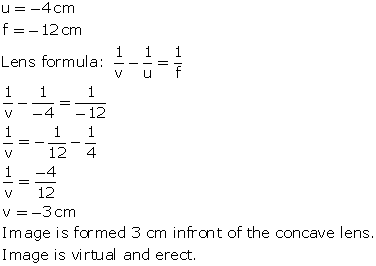
Solution 4
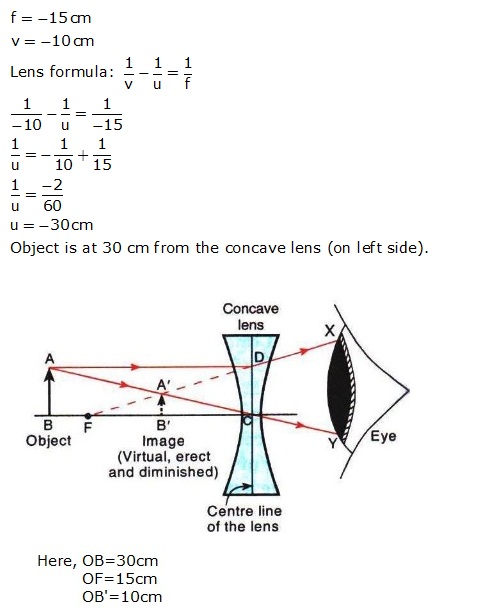
Solution 5

Solution 6
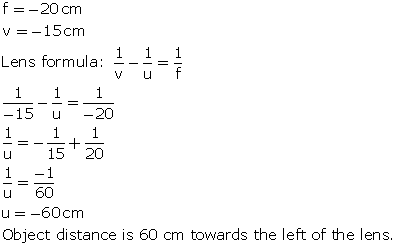
Solution 7
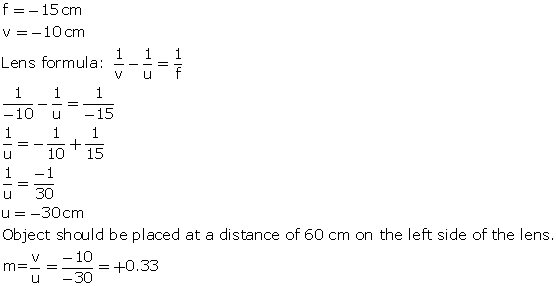
Solution 8
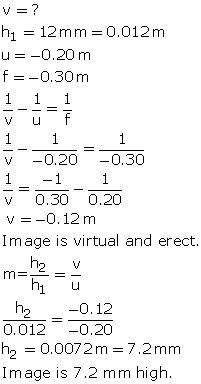
Solution 9
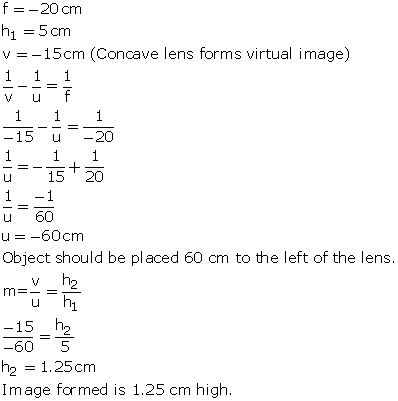
Solution 10

Solution 11

Solution 12

(b) Formation of image in case (i):
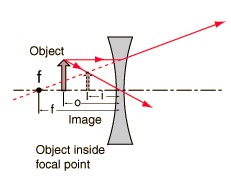
Formation of image in case (ii):
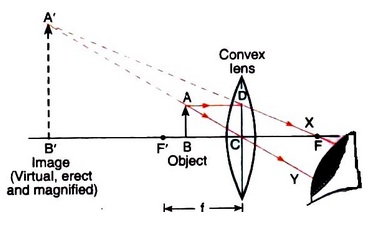
Solution 13
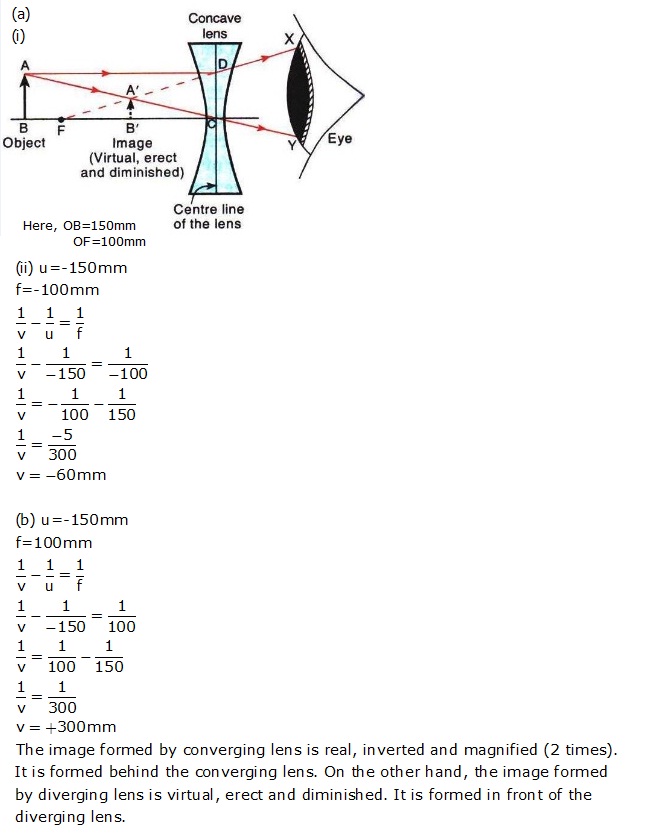
Refraction of Light Exercise 257
Solution 18
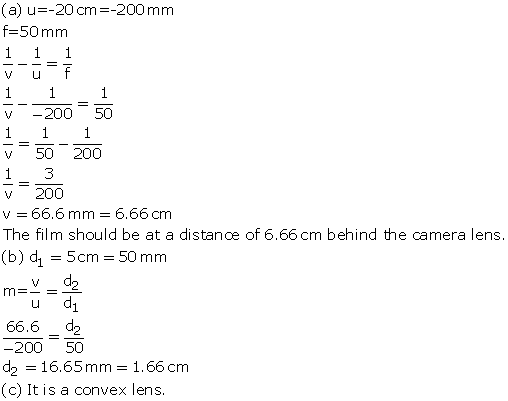
Solution 19
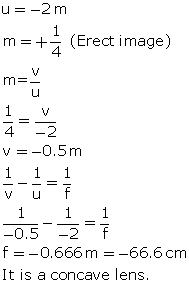
Solution 20

Refraction of Light Exercise 261
Solution 1
Solution 2
Convex lens of short focal length causes more bending of light rays passing through it.
Solution 3
Power of a lens
Solution 4
1 diopter is the power of a lens whose focal length is 1 metre.
Solution 5
a) Positive power - Convex lens
b) Negative power - Concave lens
Solution 6
Lens of short focal length
Solution 7
Power of lens is reciprocal of its focal length in metres.
Solution 8
Thick convex lens has more power because of its shorter focal length.
Solution 9
P = 1/f = 1/0.25 = +4 D
Solution 10
f = 0.5 m
P = 1/f = 1/0.5 = +2 D
Solution 11
f = 50 mm = 0.05 m
P = 1/f = 1/0.05 = +20 D
Solution 12
f = 80 cm = 0.8 m
P = 1/f = 1/0.8 = +1.25 D
Solution 13
P = 1/f = 1/(-0.03) = -33.33 D
Solution 14
P = +0.2 D
P = 1/f
f = 1/P = 1/0.2 = +5 m
Solution 15
P = -2 D
P = 1/f
f = 1/P = 1/(-2) = -0.5 m = -50 cm
Solution 16
Convex lens
Solution 17
Concave lens
Solution 18
(a) Convex lens
(b) P = +0.5 D
P = 1/f
f = 1/P = 1/0.5 = 2 m
Solution 19
P = 1/f
f = 1/P = 1/(-0.5) = -0.66 m = -66.6 m
Since focal length is negative, it is a diverging lens.
Refraction of Light Exercise 262
Solution 20
P = 1/f = 1/(-0.1) = -10 D
It is a concave lens.
Solution 21
f = +150 mm = +0.15 m
It is a convex lens since its focal length is positive.
P = 1/f = 1/0.15 = +6.66 D
Solution 22
(a) power, dioptres
(b) positive, negative
Solution 23

Solution 24
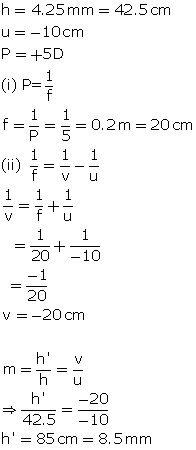
Solution 25
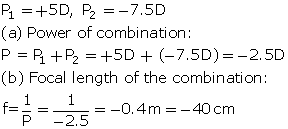
Solution 26

Solution 27
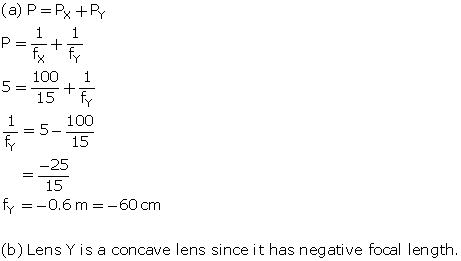
Solution 28
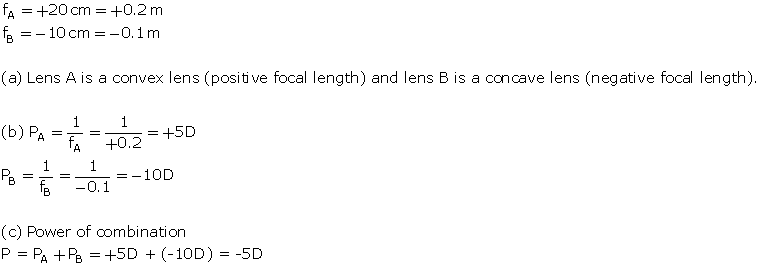
Solution 29
(a) Power of a lens is a measure of the degree of convergence or divergence of light rays falling in it.
Power of a lens depends on its focal length.
(b) Unit of power of a lens is dioptre.
One dioptre is the power of a lens whose focal length is 1 metre.
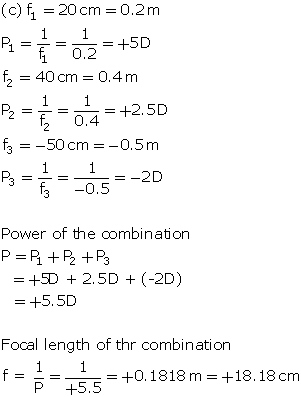
Solution 30
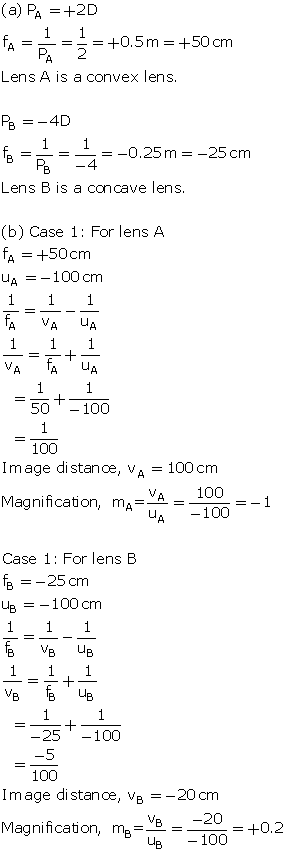
Refraction of Light Exercise 263
Solution 39
(a) These lenses have negative powers and hence negative focal lengths, so they are concave lenses.
Concave lenses are thinner in the middle.
(b) Lens of lower power has greater focal length.
So, -3.50 D lens has greater focal length.
(c) Left eye is the weaker one because it needs a lens of greater power for its correction.
Solution 40
(a) These lenses have positive powers and hence positive focal lengths, so they are convex lenses.
Convex lenses are thicker in the middle.
(b) Lens of greater power bends light rays more quickly.
So, +2.50 D lens bends light rays more quickly.
(c) These spectacle lenses will converge the light rays because these are convex lenses.

